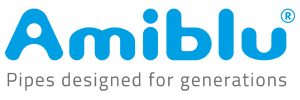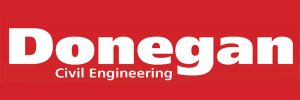Blackburn and Darwen WwTWs (2020)
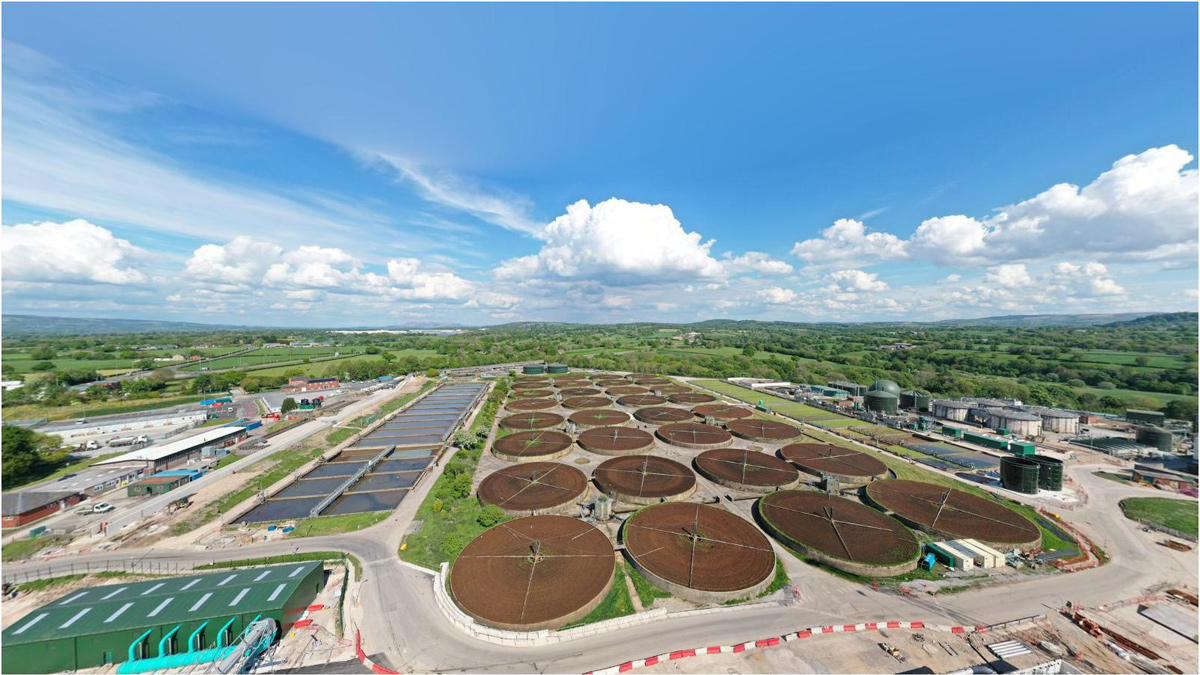
Blackburn WwTW - Courtesy of United Utilities
Blackburn WwTW, located at Samlesbury near Blackburn, serves a population equivalent (PE) of approximately 400,000 and discharges final and storm effluent to watercourses that are tributaries of the River Darwen, feeding into the River Ribble estuary and ultimately into the bathing waters of the Fylde coast in the Irish Sea. Over the last 12 months, construction work at at Blackburn has significantly progressed to accommodate AMP7 requirements. This paper is the fourth in a series of case studies detailing the ongoing work at Blackburn, Darwen and the Nab Head sites, following on from:
- Blackburn and Darwen WwTWs (2017) article.
- Blackburn and Darwen WwTWs (2018) article.
- Blackburn and Darwen WwTWs (2019) article.
Undertakings
LiMA, a joint venture between Laing O’Rourke and Atkins, one of United Utilities AMP6 construction delivery partners, was appointed in December 2017 as main contractor for the works at:
- Blackburn Wastewater Treatment Works.
- Darwen Wastewater Treatment Works.
- Darwen Pipeline.
- Nabs Head Inlet Works.
Improvement works at the above four sites will address the AMP6 and AMP7 requirements to improve the river and bathing water quality. The project is on target to be completed in 2021.
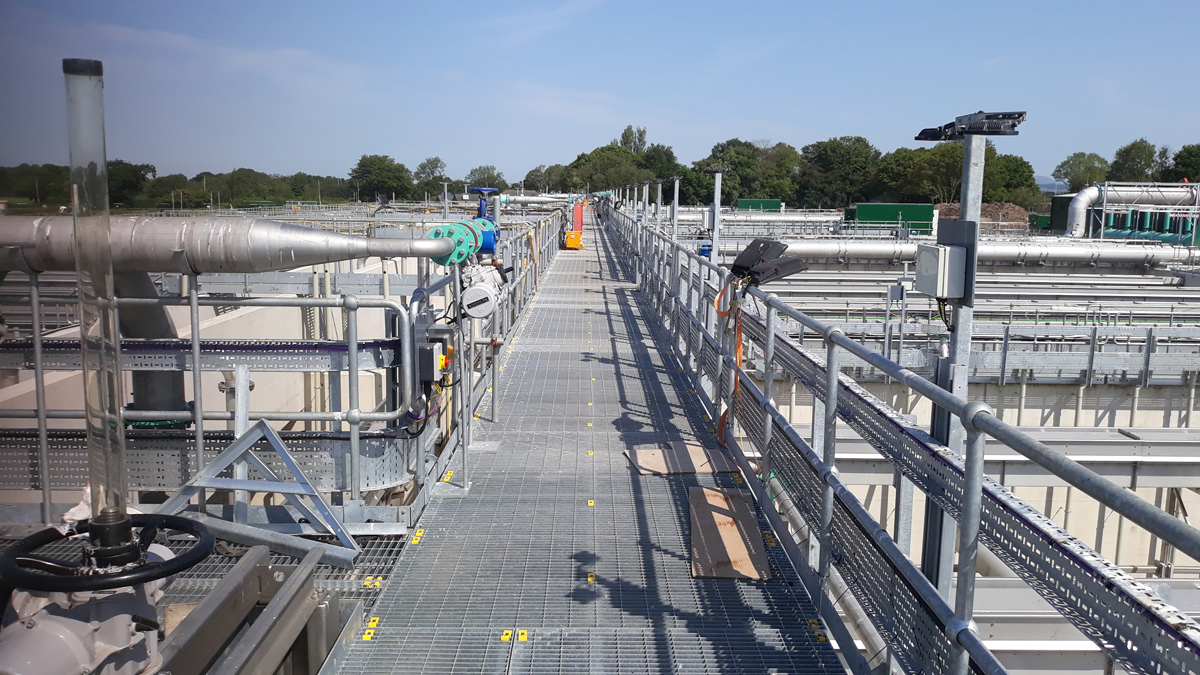
Nereda tank Cells 6 looking north along the 890m walkway (May 2020) – Courtesy of United Utilities
Blackburn WwTW
The works, built in the 1960s, treats principally domestic crude sewage from the Blackburn catchment, with two major additional contributions; a high strength trade effluent from the InBev brewery and an ammonia rich return liquor flow from the sludge treatment plant. The key river water quality/water framework directive parameters within the revised environmental permit are the need to achieve a BOD of 7 mg/l and ammonia of 1 mg/l both on a 95%ile basis.
It was identified at an early stage that the benefits of maintaining a gravity solution through the treatment process, taking advantage of the natural topography of the site, would avoid the need for the ongoing costs of interstage pumping. In the last 12 months hydraulic levels of the cloth filters and UV plant have changed further to accommodate further AMP7 requirements, (changes to ferric dosing, coagulation, flocculation and up to a further 10-15 filters). This change has been made to again maximise gravity flow on site and avoid significant future pumping, power use and also to reduce the environmental impact of additional power use.
Scope of works
A new inlet channel to feed a 72,000m3 in situ concrete structure which houses the new innovative Nereda® aerobic granular biomass technology. The Nereda system will treat crude sewage that has only received preliminary treatment at Nabs Head and has been developed to treat the full flow and peak load at the works; i.e. a complete replacement and expansion of the existing wastewater treatment plant with a flow to full treatment (FTFT) of 3,000 l/s. The Nereda structure comprises of:
- 6 x 12,000m3 Nereda reactors.
- 2 x 800m3 Nereda sludge buffers.
- 1 x 800m3 Nereda water level correction buffer.
- Associated aeration and pumping equipment.
Drainage, backfill and landscaping works around the tank has made significant progress in period. Further to the above the blower building has now been constructed including a pipe bridge across the main site access road to reach the Nereda. The building contains 5 (No.) HSTTM 30 Turbocompressor Sulzer blowers with a pipework network to each Nereda cell.
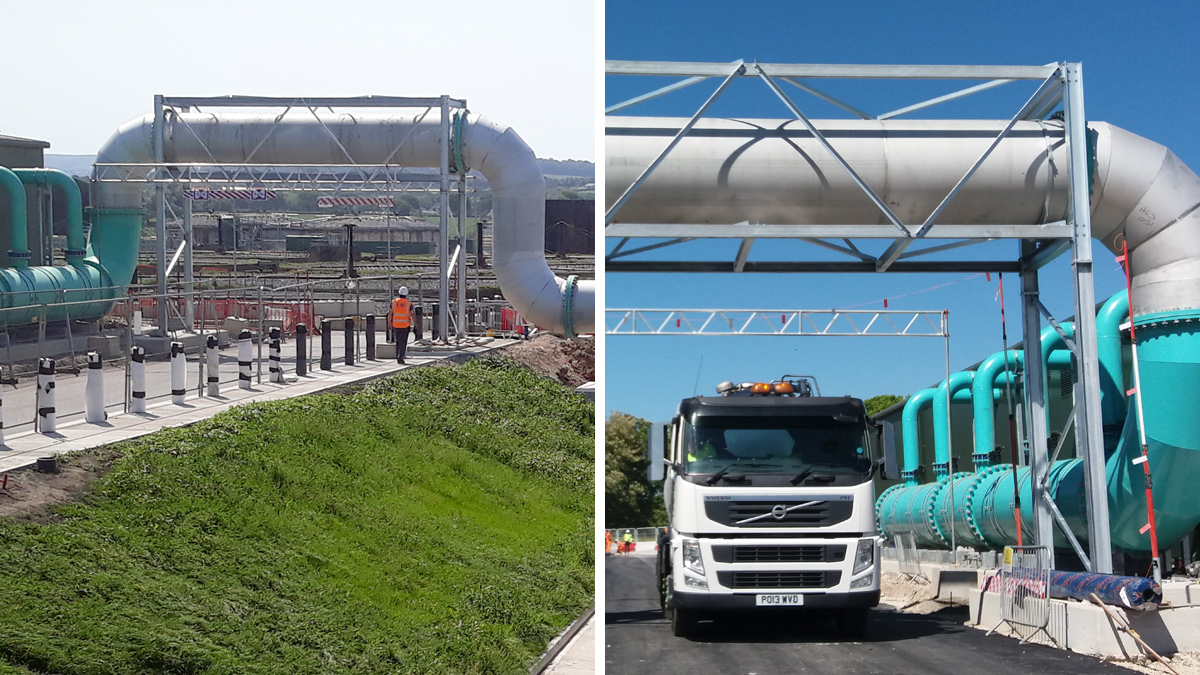
Pipe bridge between blower building and Nereda tank (May 2020) – Courtesy of United Utilities
Construction of the 10 (No.) Mecana SF21 permanent filter bank from Eliquo Hydrok Ltd is in the final stages and the first two filters are being installed and commissioned in the permanent location. There is phased commissioning approach to move the filters in pairs from their existing operational position into the permanent filter bank as commissioning stages are ramped up.
Further to this the SAS plant, poly posing, sludge holding tanks, drum thickeners and lamella areas have been constructed and equipment installed, and at the time of writing (June 2020) are in the process of being commissioned.
The development of a federated model including the use of 3D visualisation tools is one innovation to speed up the build and construction process. These have been used to facilitate the design development with integration of hazard management, safety and access, lifting and maintenance reviews with our operational teams to achieve the most efficient design prior to construction. This in turn is being integrated with UU’s system thinking philosophy to allow operational benefits to enhance the way the plant is maintained and operated in the future from both site and the integrated control centre.
The project has utilised SYNCHRO 4D to visualise the construction and link drone 3D scanned data to the development of the build and the programme encompassing a truly impressive build model that is safety, reliability, predictability and quality this complex construction project. This has supported the complex mechanical installation within the Nereda cells.
Works has been impacted by the recent COVID-19 outbreak including third party, planning, production, deliveries and availability of resources. However joint working between United Utilities and LiMA has ensured a safe working environment could be maintained for site teams with many areas of good practice implemented.
Ferric dosing and tertiary treatment: Early works were implemented at Blackburn to dose upstream of both the primary settlement tanks and humus tanks to achieve the new phosphorous permit of 1 mg/l from November 2018. The package dosing unit was supplied by Galliford Try which was installed and commissioned prior to the regulatory date and is operating successfully. With potential concerns over levels of iron in the final effluent, 8 (No.) Eliquo Hydrok Ltd Mecana pile cloth media filters with interstage pumping in a temporary position downstream of the existing humus tanks. This was to ensure the 4 mg/l permit was not at risk. These filters will be moved into the permanent filter bank location as part of a phased transfer during the commissioning process, where they will operate at reduced power consumption under the natural gravity of the site.
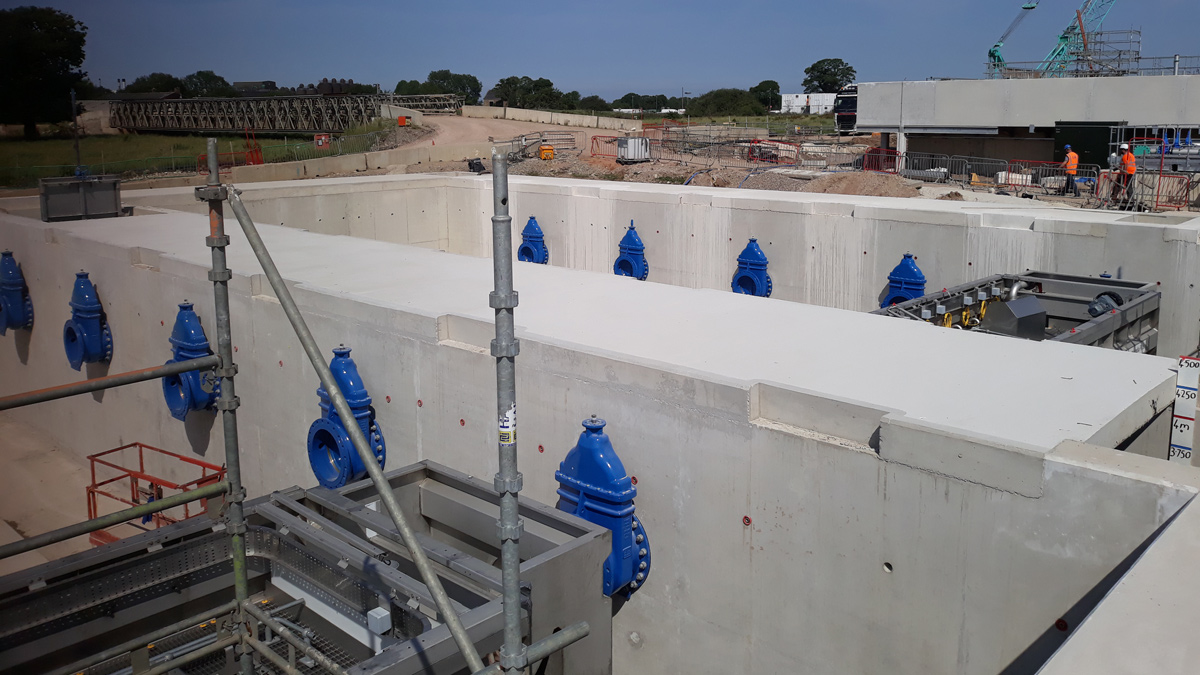
Permanent cloth filter block at the south end of the Nereda tank – Courtesy of United Utilities
BOD compliance: To achieve compliance with the revised BOD permit, it was identified at tender stage that tertiary treatment would be required. The treatment selected was a pile cloth media filters (PCMF) for the removal of suspended solid particles, with 10 (No.) Mecana SF21 filters being required in the permanent installation downstream of the Nereda plant.
UV disinfection: A new UV disinfection system to be supplied by Xylem Water Solutions, is designed to treat the final effluent prior to discharge, meeting the EA requirements for compliance with the Bathing Water and Shellfish Directives. Several studies have been undertaken:
- Coastal modelling work has been undertaken by Intertek to determine dilution factors.
- UV transmittance levels have been monitored on the existing site.
- The collection of samples at other sites for collimated beam testing to understand the impact of characteristics of Nereda based effluent on dose-response.
This work has been coordinated by Stantec UK and has enabled the development of a dose-response relationship for the final effluent disinfection and also to determine the UV dose required to meet the required concentration for the target organism based on a site specific information in accordance with the United Utilities Asset Standard. This has resulted in completion of the UV design, planning application and build of the asset.
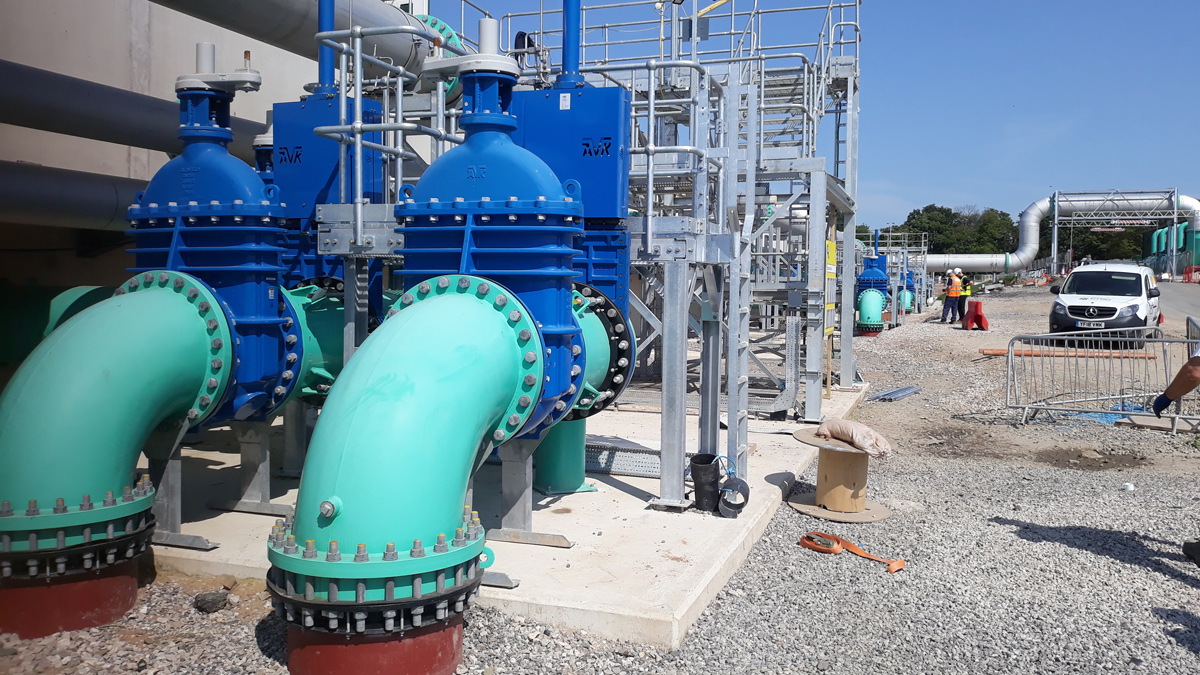
Nereda tank pipework and valve arrangement (May 2020) – Courtesy of United Utilities
Blackburn & Darwen WwTWs: Supply chain/key participants
- Project delivery contractor: LiMA
- Civil design: Atkins
- Nereda® process: Royal HaskoningDHV
- Tertiary filtration: Eliquo Hydrok Ltd
- UV treatment: Xylem Water Solutions
- Package dosing unit: Galliford Try
- Physical model: Hydrotec Consultants
- Mechanical installation – pipework: FSE
- Nereda internal installation: Crown House Technologies
- Nereda internal installation: Suprafilt
- LV electrical installation, MCCs: Lloyd Morris Electrical Ltd
- Systems integration: Tata Consultancy Services
- Package inlet works: M and N Electrical and Mechanical Services
- Drum thickeners: Huber Technology
- Blowers: Sulzer Ltd
- Transfer pipeline & tunnel: VJ Donegan Civil Engineering Ltd
- Steelwork: Galloway Group
- Tanks: Stortec Engineering Ltd
- Penstock, stoplogs, valves: Glenfield Invicta
- Lamella: Jacopa Ltd
- GRP Pipe: Amiblu Norway AS
Nabs Head Inlet Works
Nabs Head was the location of Blackburn’s original sewage farm constructed in the 1890s, (the first pipe was laid 1854) and when the new works was constructed at Samlesbury in the 1960s the original humus tanks were converted to storm tanks with a capacity of 9,400m3. The inlet works were moved back to Nabs Head in the early 1990s and comprised screening and grit removal, with an additional 10,700m3 of storm storage constructed in AMP5.
To meet both the Bathing Water Directive requirements of no more than 3 spills per bathing season, and the Shellfish Waters Directive of no more than 10 spills per annum (which proved to be the governing factor), the solution increases the pass forward flow (PFF) to 2,700 l/s from 1,800 l/s, as well as providing another 20,000m3 of storm water storage.
Storm storage: The new storm storage utilised the footprint of the original 1890s storm storage tanks. The two new 10,000m3 blind storm storage tanks are both 102m long by 34m wide and are pumped filled (at up to 3,000 l/s) and empty by gravity, once there is sufficient capacity to pass the flows on to the main works. Each tank will be cleaned using a 6-lane Eliquo Hydrok Ltd flushing gate system to reduce ongoing operating and maintenance costs.
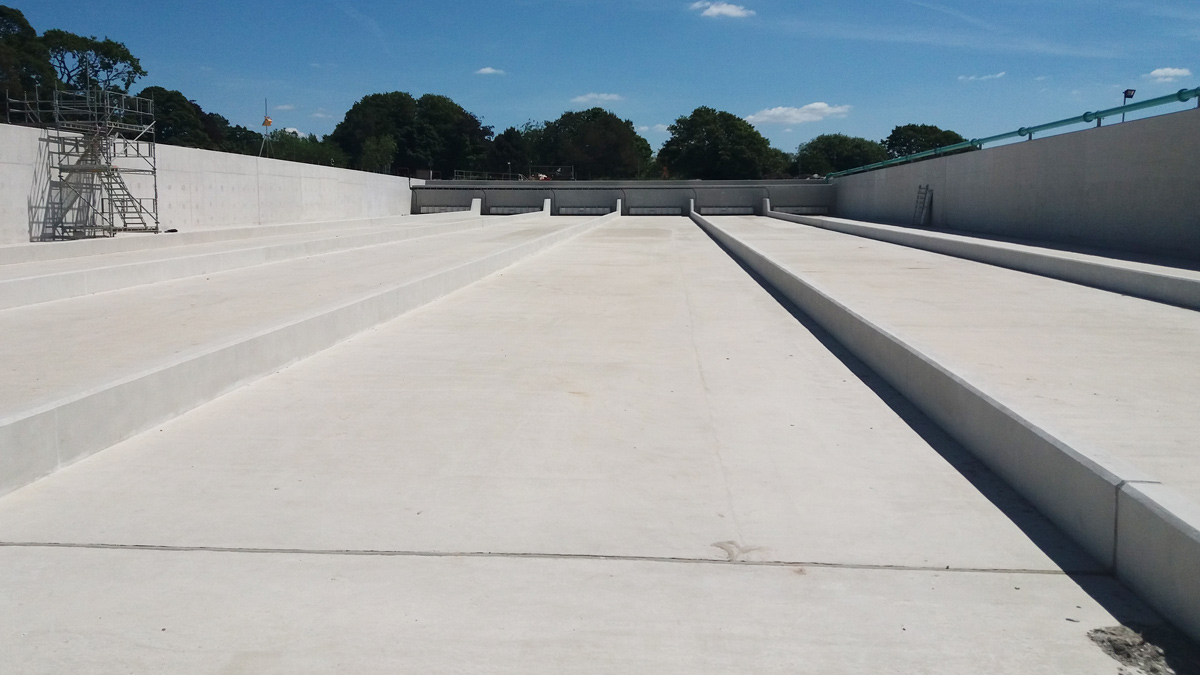
Nabs Head 20,000m3 twin tank build: view of 10,000m3 tank with six flushing lanes – Courtesy of United Utilities
A scale model of the existing CSO channel was constructed by Hydrotec Consultants to ensure that the modified arrangement could deal a range of flows ranging from 30 year storm events to the impact of the return of the storm tank contents during low flows. Hydrotec also built a model of the new storm pumping station to ensure the proposed overflow and baffling arrangement avoided pre-swirl rotation issues with the flows arriving at the 4 (No.) submersible centrifugal pumps.
Screenings: Works to refurbish the 4 (No.) existing Longwood escalator screens has been completed and the installation of the 4 (No.) new Kuhn Washpresses from M and N Electrical and Mechanical Services to wash and compact the extracted screenings is 50% complete. In addition the two existing cross flow detritors are being refurbished with new grit scrapers, grit pumps and classifiers also 50% complete. Thermal imaging cameras are being used to detect fill capacity on both the screenings and grit skips, to provide a robust operating system without the need for a more complicated auto skip changeover arrangement. The ram pumps are also commissioned.
Fibre optics: A new fibre optic link has been installed to enhance signalling between Blackburn WwTW and Nabs Head to allow swifter communication of flow changes and alarms connecting directly into our central management platforms.
Washwater: A new washwater main is being installed between Blackburn and Nabs Head to facilitate final effluent for the screens and compactors.
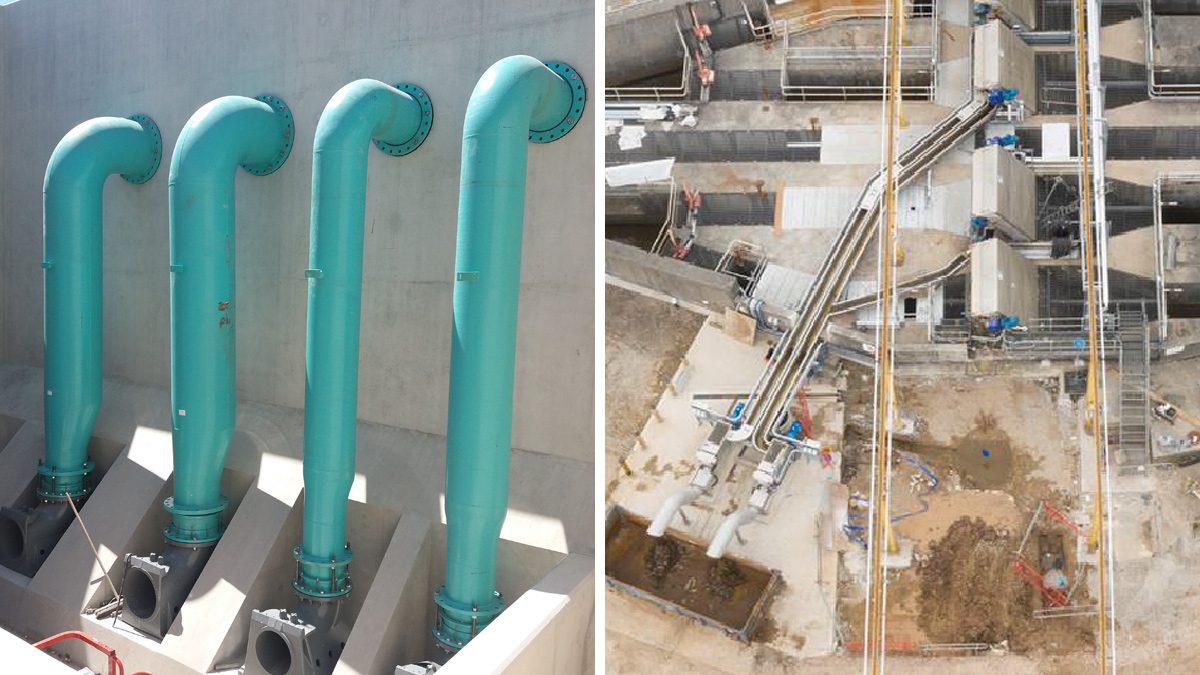
(left) Nabs Head Pumping station showing 4 (No.) submersible centrifugal pumps and (right) Nabs Head screenings works showing 4 (No.) screens, 2 (No.) Kuhn Washpresses with associated launders (area cleared ready for construction for of two additional Washpresses – Courtesy of United Utilities
Darwen WwTW
Like Blackburn the works were built in the 1960s and comprises:
- Inlet works.
- Primary settlement tanks.
- Trickling filters.
- Humus tanks.
A new energy intensive treatment process would have been required to achieve the treatment element of the Water Framework Directive (WFD) driver and the lowest cost solution identified was to abandon the works and transfer flows under gravity into the adjacent Blackburn drainage catchment, ultimately receiving treatment at the new Blackburn WwTW.
Initial works at Darwen required the installation of a ferric dosing system, to dose upstream of the primary settlement tanks and achieve the new phosphorous permit of 2mg/l from November 2018. A package dosing unit was supplied by Galliford Try which was installed and commissioned prior to the regulatory date. This plant is running successfully and achieving consent.
The second WFD element at Darwen WwTW required the reduction of intermittent discharges by increasing the volume of storm water storage, to meet the required river water quality (FIS/RE 99%ile) standards. The best whole life cost design is the refurbishment and conversion of what would become redundant primary settlement and humus providing some 6,000m3 of storm storage facilities with a pass forward of 517 l/s via the transfer main. This design is currently being finalised.
Darwen pipeline
This will initially pass underneath the M65 motorway in a tunnel before reverting back to a traditional gravity sewer construction as it passes alongside a residential and business developments, a river and along Branch Road. As at June 2020, 25% of the pipeline has been installed by VJ Donegan Civil Engineering Ltd. The solution submitted at the tender stage for a 1.6km pipeline of 700mm diameter remains substantially unchanged, although some route realignment had to be made due to significant service congestion on the route. Network modelling work has been undertaken to confirm the storm water storage requirements and ensure that flows diverted from Darwen into the Blackburn catchment cause no ‘level of service’ issues within the existing sewer network.
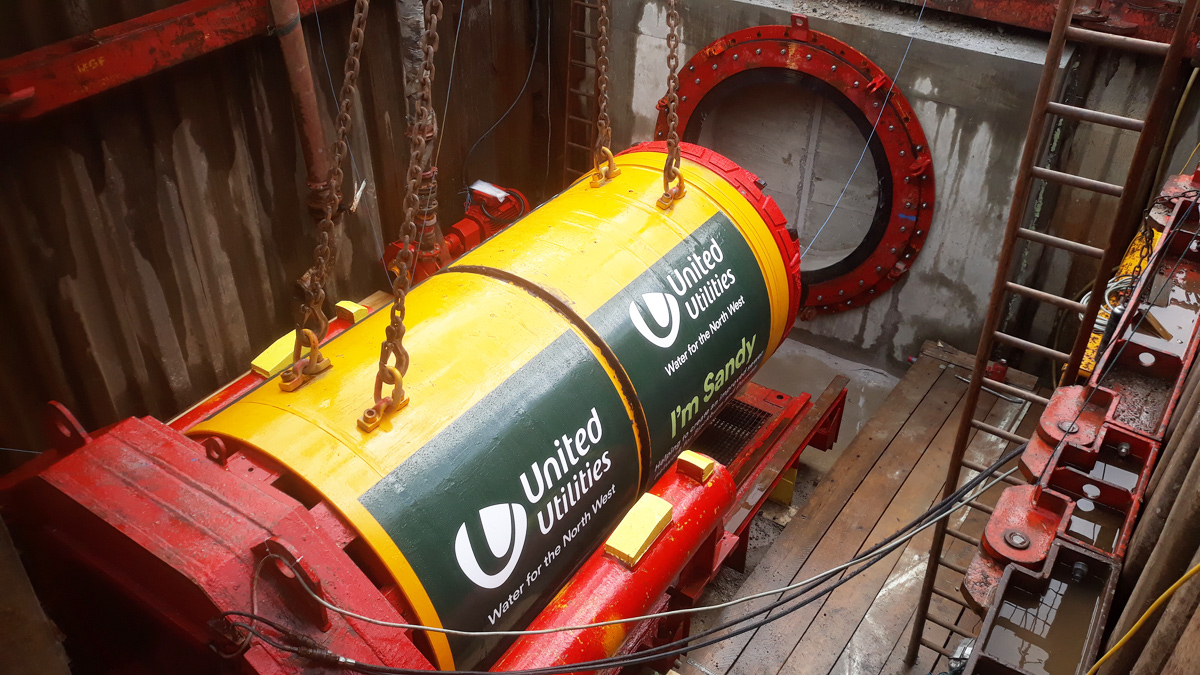
TBM being lifted into position for M65 motorway crossing – Courtesy of United Utilities
A Section 61 agreement has been agreed with the support of Highways England for the pipeline to traverse 16m under the M65 motorway to facilitate a key section of the pipeline route. The tunnel boring machine is currently (July 2020) being lifted into position to imminently start the drive.
Progress/current status
At the time of writing (July 2020), The Nereda structure mechanical installation is 95% complete, with commissioning works scheduled to commence in August 2020. The tertiary and UV plant build is ongoing, and the Nabs Head works are reaching the final stages. The transfer main pipeline and Darwen design is ongoing, (25% complete). The project is due to be successfully implemented in 2021.



